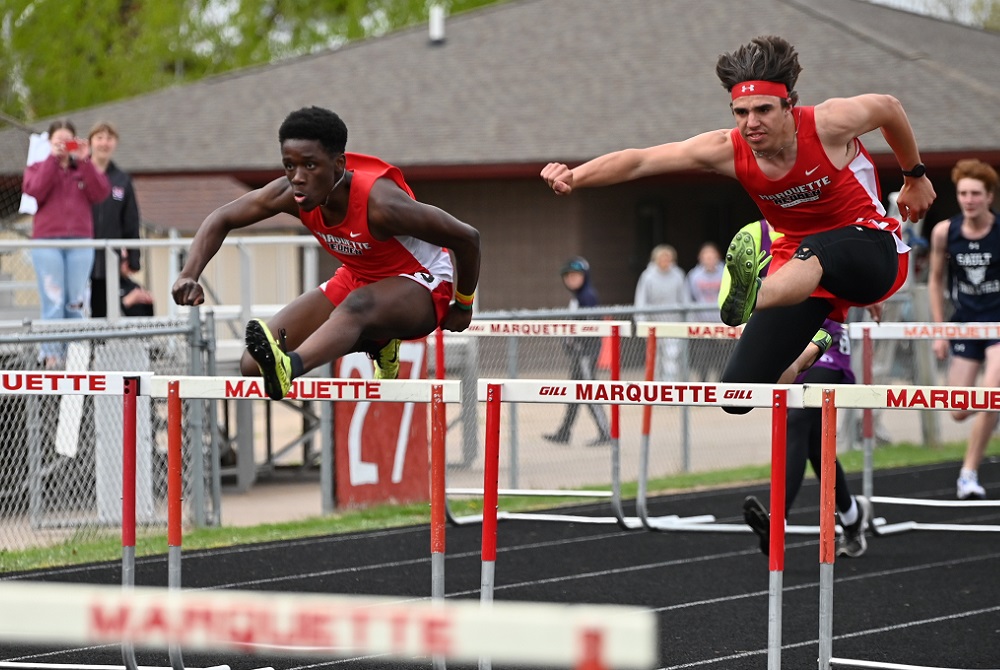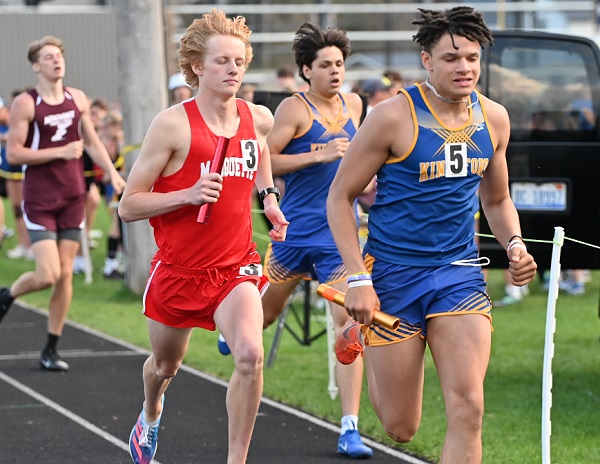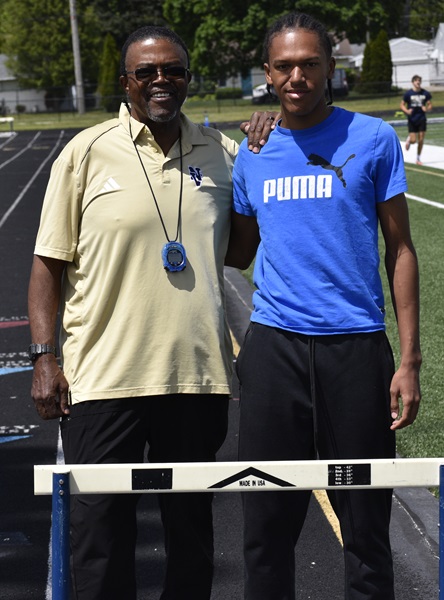
Preview: UP Boys Finals Feature Fierce Team Races, Statewide Headliners
By
Geoff Kimmerly
MHSAA.com senior editor
June 2, 2022
There’s an excellent chance many statewide eyes turn to Saturday’s Upper Peninsula Boys Track & Field Finals at Kingsford High School.
Start in high jump, where Menominee’s Brady Schultz is one of four athletes sharing the top performance in that event in Michigan this season. Ishpeming’s Jonny Matson is another intriguing story; he’s the top seed in four individual events, and if he wins all four will become just the ninth athlete in state history to do so at the MHSAA Finals. Powers North Central’s Luke Gorzinski and Ewen-Trout Creek’s Jaden Borseth are Division 3 contenders who have starred leading their teams to statewide Finals in football and basketball, respectively.
Of heightened interest closer to home, annual favorites Marquette and Ishpeming could face tough challenges in team title competition from Kingsford and Iron Mountain, respectively. Dollar Bay, a first-time team champ in 2021, will look to add another but with Pickford and Munising perhaps the favorites in Division 3 this time around.
Events begin at 10 a.m. (EDT) and tickets to attend can be purchased online only at GoFan. The meets also will be broadcast on MHSAA.tv and viewable with subscription.
Below is a glance at team contenders and individuals to watch in all three divisions.
Division 1
Team forecast: After seeing its latest Finals win streak end at four with Gladstone taking the 2019 championship, Marquette returned off the COVID year with a win ahead of runner-up Gladstone in 2021. Marquette also was first at its Regional two weeks ago, scoring nearly as many points as the other four teams combined. But watch out for Kingsford. The Flivvers, seeking their first team title since 2014, have qualifiers all over the meet and are seeded to have five event champions. Houghton has similar star power and potential for points.
Dryden Nelson, Calumet senior: The Copper Kings’ standout won the 100 and long jump last year, and he’s seeded first in the 100 (11.31) and second in the 200 (23.58) and long jump (19-11½). He will also run on the 400 relay.
Sasha Olsen, Gladstone senior: Last season’s pole vault champion also was fourth in high jump and is seeded third (5-9) in that event and will run on the 400 relay.
Brady Schultz, Menominee senior: Schultz’s 6-7 in high jump at his Regional was seven inches higher than anyone else in UPD1, and his best of 6-9 remains tied for best in the state this spring. He set the UPD1 meet record last year at 6-8. He’ll also run on three relays including the second-seeded 800 and 1,600.
Lucas Tappy, Kingsford senior: The reigning shot put champion is top-seeded in that event by 3½ feet with a Regional toss of 46-2½.
Carson VanderSchaaf, Marquette junior: This half of the distance twin duo is the top seed in the 1,600 (4:35.72) and 3,200 (9:59.88) and won the 3,200 last season.
Colin VanderSchaaf, Marquette junior: The reigning champ in the 1,600 is second-seeded to his brother by 12 hundredths of a second at 4:35.84 and top-seeded in the 800 (2:05.42) by less than a tenth of a second ahead of Houghton standout Eric Weiss. VanderSchaaf also will run the 400 and on the top-seeded 1,600 relay.
Division 2
Team forecast: The Hematites shared championship last season with Norway was its third straight title and sixth over the last seven seasons. Its Regional win two weeks ago came in part thanks to 10 event championships, and the team has six top seeds based on those performances. Iron Mountain has a qualifier in all but one event Saturday as it seeks its first team title since 2008.
 Eric Edwards, Newberry senior: Last season’s shot put champion is the second seed this time (42-6¼) and will run on two relays including the top-seeded 800.
Eric Edwards, Newberry senior: Last season’s shot put champion is the second seed this time (42-6¼) and will run on two relays including the top-seeded 800.
Nathan Hochstein, L’Anse senior: After sweeping the jumps last spring, Hochstein is the top seed in the high jump (5-7) and fifth in long jump (17-3), and may also run the 400 and on up to two relays.
Christian Koiveniemi, St. Ignace senior: The reigning 100 champ is seeded in the middle of that race and the 200 and tied for the second seed in the high jump (5-6). He’ll also likely run on the top-seeded 400 relay.
Jonny Matson, Ishpeming senior: He enters his first Finals as the top seed in all four of his events – the 100 (11.68), 200 (24.06), 400 (54.06) and long jump (20-0).
Eli Ostermeyer, L’Anse senior: The reigning discus champion is top-seeded in that event (122-9½), and third in shot put (41-9¼) coming off last season’s runner-up finish in that throw.
Landon Sundelius, West Iron County senior: He won the 300 hurdles and was fourth in the 110 last season, but enters Saturday seeded first for both in 41.59 and 17.34, respectively.
Trevor Visnaw, St. Ignace sophomore: Las season’s pole vault champion is seeded second (10-6) and could run two relays, including on the top-seeded 400.
Division 3
Team forecast: Dollar Bay claimed its first Finals championship in this sport last season, edging Pickford by 12 points. Both should be in the mix Saturday, plus Munising is seeking its first team title since winning back-to-back in 2014 and 2015. The Mustangs have top seeds in four events, while Pickford has qualifiers in every event but one. An interesting addition is Norway, which shared the Division 2 championship last season and finished second at its Regional last month to Stephenson.
Jaden Borseth, Ewen-Trout Creek senior: The basketball standout is also a rare four-field event athlete and the top seed in the discus (127-9). He’ll also compete in the shot put and as the third seed in the long jump (18-9½), and placed in high jump as a junior.
Luke Gorzinski, Powers North Central junior: The 8-Player Finals championship quarterback is also the reigning UPD3 champ in the 200. He’s the top seed in the 100 (11.38), second in the 200 (23.92) and could run on two relays including the top-seeded 800.
Trenton Naser, Powers North Central senior: He finished second in the 300 hurdles and fourth in the 110 last season, but is the top seed in both this weekend at 44.04 and 16.94, respectively. He’s also slated for multiple relays including possibly the 800.
Micaiah Peramaki, Munising junior: After finishing runner-up in the 100 and third in the 200 last spring, Peramaki enters seeded second in the 100 (11.72) but first in the 200 (23.65) and 400 (53.31) – and also second-seeded in the discus (121-8).
Nikolas Thomas, Dollar Bay senior: He contributed to Dollar Bay’s first team title scoring points in the 1,600 and 3,200 and as part of last season’s winning 3,200 relay. He’ll have a much larger role in any repeat attempt as the top seed in the 800 (2:06.08), 1,600 (4:44.86) and 3,200 (10:46.15) and fourth seed in the 400 (54.43).
PHOTOS (Top) Marquette’s Lamb Ngafeeson (left) and Samuel Markey are step for step with each other near the start of their 110 hurdles Regional race last month. (Middle) Kingsford’s Cardel Morton (5) retains a slight lead on Marquette’s Colin VanderSchaaf (3) after the final handoff of the 1,600 relay at the May 13 Negaunee Lions Invitational. (Photos by Cara Kamps.)
McCarey Caps Niles Career Among School's All-Time Track Greats
By
Scott Hassinger
Special for MHSAA.com
June 3, 2025
NILES – For such a decorated athlete, Niles track & field star Ayden McCarey is as humble as they come.
 That one trait is what makes him such a joy to coach, says Tony Todd, the Vikings' longtime leader of the boys program.
That one trait is what makes him such a joy to coach, says Tony Todd, the Vikings' longtime leader of the boys program.
Todd, a Flint Kearsley graduate and former participant himself in the oval sport, has seen many great performers during his 27 years directing Niles' program. But he contends that McCarey is one of the best he's ever coached.
McCarey, who has signed to run track at the Division II level at Grand Valley State University, capped off a glorious high school career during Saturday's Lower Peninsula Division 2 Finals in Hamilton.
McCarey returned home with all-state honors in two events, finishing second in the 110-meter high hurdles (14.43) and third-place in the 400-meter dash (49.27). His time in the 110s broke the school record. He has the second-fastest time at the school in the 400 dash, less than a second behind 2018 Niles grad Jordan Brown, currently the Vikings' sprint coach, who owns the record at 48.50.
McCarey also qualified in the 300 intermediate hurdles and ran anchor leg for the Vikings' 1,600 relay on Saturday.
"Ayden relishes the competition. The bigger the meet, the more he seems to rise to the occasion and perform well. When someone has a faster time, he can't wait to race against them. He gets excited over the chance to compete against someone faster," Todd said.
Also a standout defender for the Niles boys soccer team, McCarey finished runners-up in both the 110 highs and 400 his junior year. As a sophomore he placed sixth in the 110 and 10th in the 300. He began competing in the 400 midway through his sophomore season.
"It's just nice to know that all your hard work you put in got you to state. There's a lot of competition there. I am just happy to represent my school for a third time," McCarey said.
He credits an increase in distance workouts and his increased focus on the 400 as big reasons for his improvement in that event this season.
 "I try and focus on all my events, but it just so happened I spent the most time focusing on the 400 this season,” McCarey said. “You need a lot of stamina to run that event, and it also helps me in the longer hurdle race as well. I've been successful in the 110 highs because I concentrate on attacking it whereas most people sometimes hop over them and that slows them down and hurts their time. I get a good start, and I'm able to maintain my speed throughout the race."
"I try and focus on all my events, but it just so happened I spent the most time focusing on the 400 this season,” McCarey said. “You need a lot of stamina to run that event, and it also helps me in the longer hurdle race as well. I've been successful in the 110 highs because I concentrate on attacking it whereas most people sometimes hop over them and that slows them down and hurts their time. I get a good start, and I'm able to maintain my speed throughout the race."
McCarey owned the fastest time in the 400 among Lower Peninsula Division 2 competitors after the Regional meet. He was ranked second in the 110 highs and fourth in the 300 entering the Finals.
"Ayden goes non-stop and never complains. He's one of those kids that will run through a wall for you,” Todd said. “Sometimes I take advantage of that to get that extra effort out of him. He is very humble, and if you try and compliment him he just smiles and puts his head down and keeps going. I worry more than he does if he doesn't get the accolades that he should. He is a quiet kid who leads by example. His form in the hurdles has improved all four years."
McCarey went through his entire high school track career without an injury.
"That's a big thing. Coaches have to learn when to pull back. He's never had a serious injury that left him having to sit out a practice. You can attribute that to his extraordinary work ethic because if you slack off, that's one of the easiest ways to get hurt,” Todd said. “He stays in shape year round with his participation in soccer and track. He is very versatile and can compete at the state level in any event from the 100 up to the 400, along with the hurdles and relays.
"His conditioning and running that he does during his soccer practice builds his endurance for track. In turn, the speed he's developed in track helps him out on the soccer field."
McCarey is looking forward to competing in college.
"I decided to go to Grand Valley because they have a solid track program, and it’s not that far from home. I liked their business program there too," McCarey said.
Todd is looking forward to seeing what McCarey can do at the next level.
"The biggest thing that will make Ayden a valuable competitor in college is that he is a natural athlete. There is only so much you can coach,” Todd said. “It takes a good coach and a good athlete to make a champion. But 90 percent of that is the athlete. If they listen and do the workouts, they will succeed.
"I couldn't be more proud of his four-year high school career. He had the most outstanding track career ever at Niles High School, and he's a great human being and student. This young man is going to do great things at Grand Valley and in life. I'm proud to have been his coach for his entire high school career."
 Scott Hassinger is a contributing sportswriter for Leader Publications and previously served as the sports editor for the Three Rivers Commercial-News from 1994-2022. He can be reached at [email protected] with story ideas for Berrien, Cass, St. Joseph and Branch counties.
Scott Hassinger is a contributing sportswriter for Leader Publications and previously served as the sports editor for the Three Rivers Commercial-News from 1994-2022. He can be reached at [email protected] with story ideas for Berrien, Cass, St. Joseph and Branch counties.
PHOTOS (Top) Niles senior Ayden McCarey leaves the starting block during the 1600-meter relay at his team’s Regional. (Middle) Niles coach Tony Todd, left, takes a photo with McCarey before the start of a practice last week. (Photos by Scott Hassinger.)

